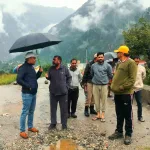Kashmir has an iconic tourist places that are famous across the globe and six Mughal gardens have been put in the tentative list of United Nations Educational, Scientific and Cultural Organization (UNESCO) in 2011.
For this, the Jammu and Kashmir administration has already prepared a dossier to include famous Mughal Gardens in the permanent list.
Heritage is our legacy from the past, what we live with today, and what we pass on to future generations. Our cultural and natural heritages are both irreplaceable sources of life and inspiration.
The celebrated Mughal gardens of Kashmir owe their grandeur primarily to Emperor Jahangir who had an undaunted love for Kashmir, and his son Shah Jahan. As per historians, Jahangir was responsible for the careful selection of the site and manoeuvring it to suit the requirements of the traditional paradise gardens.
The sites selected were invariably at the foot of a mountain, wherever there was a source of water either in the form of streams or springs. This feature eventually resulted in terraced garden layouts.
The Mughal Gardens at Nishat and Shalimar in Srinagar have always been a great attraction for the tourists visiting Kashmir.
Nishat Bagh
Laid out in the 17th century (1634 CE) by Mirza Abul Hasan, the Nishat Bagh is amongst the most prominent gardens that the Mughals developed in the undivided India. The garden is located directly along the eastern bank of Dal Lake on the foot of Zabarwan mountain range.
The garden stretches out over a rectangular area of approximately 116.70 acres, and measures about 556.50 x 350.00 m, which equals 6 quarters (3 x 2) of the traditional chahar bagh concept.
Nishat Bagh’s exceptional quality lies therefore in its setting, the complex terraced layout, the play of water cascades, the views it offers, and its ecology. Length-wise, the garden consists of twelve terraces, supposedly symbolizing the twelve signs of the zodiac.
Nishat Bagh was a more private garden than its near neighbour, the Shalimar Bagh, which was also used for holding Royal Durbars.
Shalimar Bagh
Shalimar Bagh is the largest Mughal garden in Kashmir built by Emperor Jahangir for his wife Noor Jahan in 1619, on the banks of Dal Lake in northeast Srinagar. It is believed that at Shalimar a villa was built by Pravarassena II in the late 6th Century, when the garden was a sacred site.
The small village at the site retained the name Shalimar, while the villa and garden vanished. In the 16th C. An early Muslim King, Zain-ul-Abidin, is said to have created the canal and a bund (embankment) to Shalimar.
The Farah Bakhsh, the ‘Joy-Imparting’ garden or lower garden of Shalimar Bagh was created by Emperor Jahangir around 1620. The construction was overseen by Prince Khurram, the later Shah Jahan.
The present size of the garden measures approximately 594 x 250 m and represents five main terraces that make up two and a half chahar baghs. The whole of the royal garden was divided into two major parts as per the requirement of the royalty.
Achabal Bagh
The royal garden of Achabal is located near Anantnag predates the arrival of the Mughals in Kashmir. It was renowned even during the time of the Sultans of Kashmir in the 15th century when an orchard garden existed at the site. The ancient Hindu text of Nilmat Purana mentions the existence of a spring by the name of Achapal Nag at the site.
The present garden was laid by Empress Nur Jahan in 1620 and was named after her as Begum Abad. The garden was also known as Saheb Abad during the Mughal period, in memory of the Mughal Emperor Jahangir.
The spring at the Achabal Bagh was popular at one time for its curative values and the amount of water it supplied. The Achabal Bagh, with its abundant Chinar trees and roaring water channels, is yet another embodiment of the Mughal landscape genius demonstrated in Kashmir.
A hammam was constructed within the garden by Jehanra Begum, the eldest daughter of Emperor Shah Jahan in the 17th century. The remains of an earlier baradari or pavilion can still be seen on the site of the spring.
Chashma Shahi
The garden was developed on the orders of Emperor Shah Jahan in 1632 by Ali Mardan Khan around an abundant spring emerging from the slopes of the Zabarwan Mountains. The waters of the spring are renowned for their cool and rejuvenating qualities.
Oriented on the north-south axis, the garden is arranged on three ascending terraces. The total area within the rectangular garden perimeter is approximately 1.73 acres with a width of 70.83 m and length of 122.81 m, approximately.
The spring is sheltered under a pavilion which is of a later Kashmiri period. The water from the spring, located at the uppermost edge of the garden, is led through narrow water channels that drop sharply in the form of cascades to successive lower terrace levels.
Chashma Shahi continues to retain the natural spring around which it was built and is unique for its high terraces, and distant, yet outstanding, views of the Dal Lake from its terraces.
The garden is known to be at its best during late afternoons and evenings. This garden stands out from the rest of the gardens for its narrow rills and singular fountains within its pools – adopting the typology of early Mughal gardens of India.
Pari Mahal
Pari Mahal is also located west of the city centre of Srinagar, near Chashma Shahi, on the slopes of the Zebanwan mountains. Prince Dara Shukoh, the eldest son of Shah Jahan, built the gardens around 1650.
It was built at the site of the ruins of a Buddhist Monastery and as a residential School of Sufiism at the instance of his revered spiritual tutor Mullah Shah Badakhshi. It is believed that Pari Mahal was constructed for astronomical observations and teachings or astrological calculations under the Mughals.
Dara Shukoh named it after his wife Nadira Begum, supposed to be known as Pari Begum, the daughter of Prince Parviz, a son of Jahangir.
Pari Mahal has a domed ceiling with gardens laid out on six terraces around. Arched retaining walls support the terraces, which vary in width. The garden is 122 m by 62.5 m at its widest. The terraces can be accessed via sets of steps on their corners.
The gardens are said to have been watered by a nearby spring. There are water tanks on the terraces, but unlike most Mughal Gardens in Kashmir, the garden contains no water channels and cascades (chadars) that feed the water tanks. Instead water is supplied through a system of underground pipes.
Verinag
Verinag is an octagonal pavilion-garden, built around a spring which is the acknowledged source of Jhelum River and also its principal feeder. The garden was constructed by Mirza Haider, an able engineer of the Mughal Court at the behest of Emperor Jahangir.
A Persian quatrain indicates the date of construction of the garden as 1619-20. The garden was enlarged further between 1626 and 1627, during Emperor Shah Jahan’s reign and was renamed Shahabad.
The spring is enclosed within a perfectly geometric octagonal arcade with a fairly wide stone walkway that surrounds the spring. In plan, the garden is a large octagonal tank connected to a very long and straight water channel going towards the north that reaches a point where it discharges to feed the Jhelum River.
The spring is believed to be at its deepest around 15.24 m and has abundant trout fish, which is claimed to have never been consumed owing to certain religious sentiments. This attitude has helped in maintaining the spring as a rich fish-reserve.
The garden, as many Kashmiri Mughal gardens, was repaired extensively during the Dogra period in the 1870s. The outstanding quality of Verinag is the blend of the surrounding landscape with the formal geometry of the garden. Verinag was the personal favourite of Emperor Jahangir and it was his great wish to be buried there.
Srinagar: A creative city of craft & folk arts
In 2021, Srinagar was among 49 cities across the world to make it to the coveted list of UNESCO Creative Cities Network (UCCN). Srinagar was designated a “Creative City of Craft and Folk Arts”.
It became the sixth Indian city to join the list. Chennai and Varanasi – UNESCO cities of music, Jaipur – UNESCO city of crafts and folk arts, Mumbai – UNESCO city of film and Hyderabad – UNESCO city of gastronomy, have made it to the list in the past.
Amar Singh College
Earlier in 2020, Amar Singh College, Srinagar was awarded the prestigious Award of Merit in the UNESCO Asia-Pacific Awards for Cultural Heritage Conservation. The 48 projects that were received collectively represent a significant achievement in the progress of conservation in the Asia-Pacific region. Project entries were diverse in scope and typology and were submitted from nine countries across the Asia-Pacific region. The restoration of the Amar Singh College brought back one of the most prominent institutional buildings in Kashmir to its former glory.
(With inputs form UNESCO)





